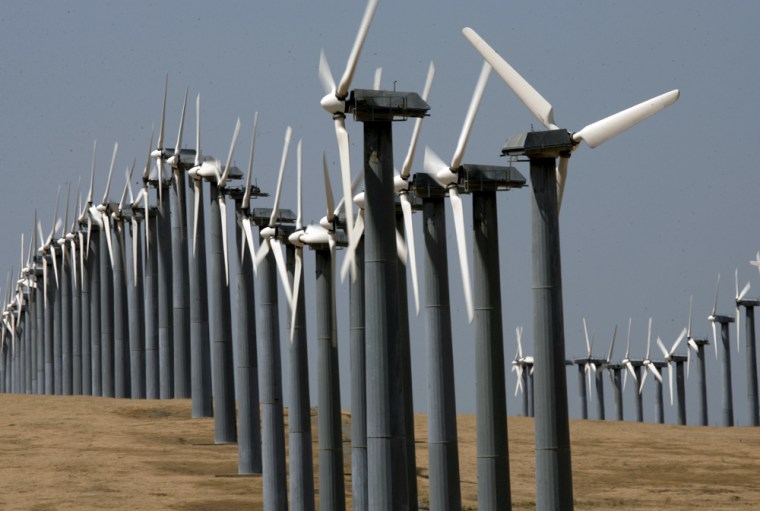By any yardstick, it's an ambitious project: allow energy to flow more freely across the nation's three massive power grids, breaking down significant barriers to ramping up alternative energy in the United States.
A proposed "Tres Amigas Super Station" in Clovis, N.M., would do just that, routing energy from isolated wind and solar installations to urban centers and other places that consume the most power.
New Mexico Gov. Bill Richardson, who served as President Bill Clinton's energy secretary, said the transmission station would be "historic."
"This is going to be the largest power converter in the world, making New Mexico the meeting place for America's electricity needs," he said at a news conference Tuesday to unveil the project.
The transmission hub would be located across 22 square miles in eastern New Mexico near the Texas border. Clovis was chosen because it is nearest to where the nation's three power grids — called the East, West and Texas interconnections — come closest together.
No above ground power lines
Tres Amigas would build a triangular pathway of underground superconductor pipelines, combined with AC/DC converters that synchronize the flow of power between the interconnections. The equipment allows electricity to be transferred from grid to grid.
Construction could begin in 2011 or 2012, and the hub could be running in 2013 or 2014, said Phil Harris, chief executive of the Santa Fe-based Tres Amigas.
The pipelines, 3 feet in diameter, contain hair-thin ceramic fibers developed by Devens, Mass.-based American Superconductor and can carry enough electricity to power 2.5 million homes.
"That's how we're going to break the power gridlock in this country," said Greg Yurek, the company's founder and chief executive.
American Superconductor has partnered with scientists at Los Alamos, Oak Ridge and Argonne national laboratories for two decades to develop the superconductor, which already is being used in Columbus, Ohio; and Long Island and Albany, N.Y., Yurek said.
Harris, a New Mexico native, said the transmission hub will have a 5-gigawatt capacity but will be built for an ultimate capacity of 30 gigawatts to move renewable energy out of the Southwest to the rest of the nation.
The facility will cost an estimated $600 million to build in its first phase, said Russ Stidolph, chief financial officer for Tres Amigas.
Stidolph said financing for the development stage has come from private investors and strategic partners, but long-term financing has not yet been obtained.
The strategic partners include American Superconductor, which has acquired a minority equity interest in Tres Amigas for $1.75 million in cash and AMSC stock.
Fewer blackouts promised
Richardson said the station would "help enormously" to lessen the effects of blackouts and brownouts in the East and West.
While the nation's need for renewable energy is driving the building of the hub, the transmission station could also transmit power from a nuclear or coal-powered facility.
"You've got a major oilfield here, but it's in terms of wind and solar, so let's tap that," Harris said. "We truly couldn't unleash the potential of renewables unless we found a way to put these grids together."
New Mexico alone has a potential capacity to produce 27 gigawatts of renewable energy, he said.
The Tres Amigos hub will employ 50 people and could potentially generate $4 billion in revenue annually, Richardson said. It would make money from fees utilities would pay to buy and sell electricity over the hub.
Yurek said the next step for the project is to file a request with the Federal Energy Regulatory Commission, which regulates the rates and terms and conditions of use for the East and West interconnections. Texas regulates its own grid.
But locating and building the physical connection between the grid and Tres Amigas' station would be under the purview of the states involved, said Mary O'Driscoll, a FERC spokeswoman.
O'Driscoll said Tres Amigas has not yet made any formal requests to FERC concerning the project.
